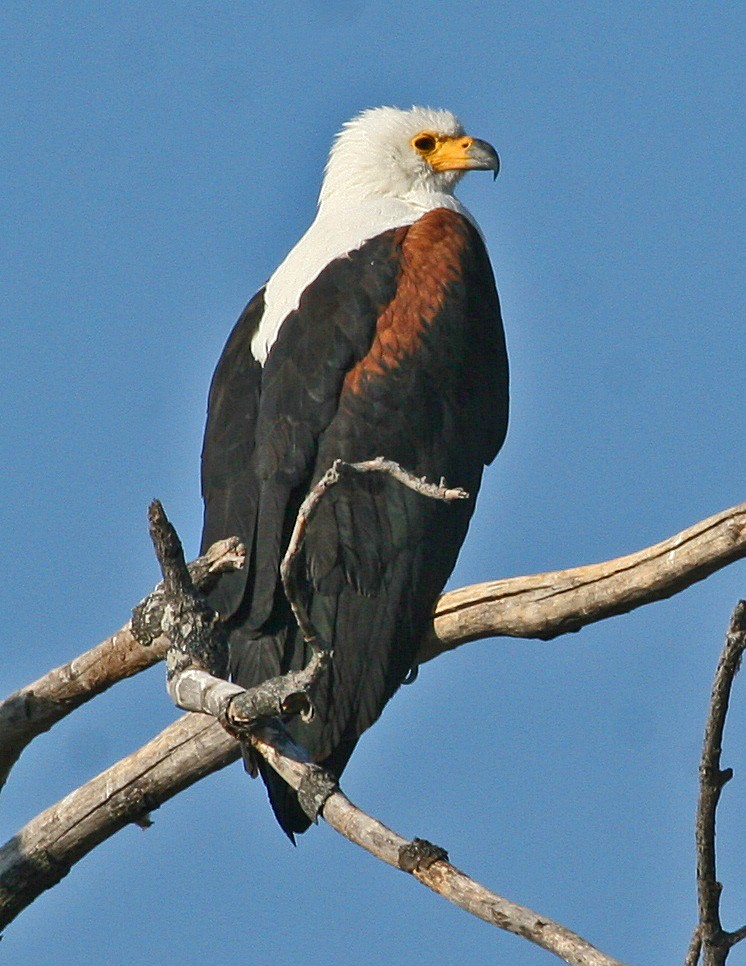African Fish Eagle
A species of Sea eagles, Also known as Cape Sea-eagle Scientific name : Haliaeetus vocifer Genus : Sea eagles
African Fish Eagle, A species of Sea eagles
Also known as:
Cape Sea-eagle
Botanical name: Haliaeetus vocifer
Genus: Sea eagles
Content
Description People often ask General Info
Description
The African fish eagle is a large bird, and the female, at 3.2–3.6 kg (7.1–7.9 lb) is larger than the male, at 2.0–2.5 kg (4.4–5.5 lb). This is typical sexual dimorphism in birds of prey. Males usually have wingspans around 2 m (6.6 ft), while females have wingspans of 2.4 m (7.9 ft). The body length is 63–75 cm (25–29.5 in). The adult is very distinctive in appearance with a mostly brown body with a white head like the bald eagle and large, powerful, black wings. The head, breast, and tail of African fish eagles are snow white, with the exception of the featherless face, which is yellow. The eyes are dark brown in colour. The hook-shaped beak, ideal for a carnivorous lifestyle, is yellow with a black tip. The plumage of the juvenile is brown in colour, and the eyes are paler compared to the adult. The feet have rough soles and are equipped with powerful talons to enable the eagle to grasp slippery aquatic prey. While this species mainly subsists on fish, it is opportunistic and may take a wider variety of prey such as waterbirds. Its distinctive cry is, for many, evocative of the spirit or essence of Africa. The call, shriller when uttered by males, is a weee-ah, hyo-hyo or a heee-ah, heeah-heeah. 
Size
73 cm
Colors
Brown
Black
Red
Gray
White
Life Expectancy
12 years
Nest Placement
Tree
Feeding Habits
African Fish Eagle primarily preys on fish, utilizing its specialized spiricules for grip. Its feeding behaviors include diving to snatch prey, kleptoparasitism, and wing-paddling if the catch is too heavy. African Fish Eagle's varied diet also includes waterbirds, reptiles, frogs, carrion, and occasionally mammals like monkeys.
Habitat
The african Fish Eagle predominantly inhabits a variety of aquatic environments including freshwater lakes, rivers, reservoirs, and occasionally coastal regions near lagoons or river mouths. Optimal habitats are characterized by open water with abundant prey and suitable perching spots. African Fish Eagle is found across many habitat types such as grasslands, swamps, marshes, rainforests, and even arid coastlines adjacent to deserts. This species can occur from sea level to high-altitude areas up to 4000 meters, adapting to temporary water bodies post-rainfall and typically nesting close to water in large trees.
Dite type
Piscivorous
People often ask
General Info
Feeding Habits
Bird food type
Distribution Area
This species is still quite common near freshwater lakes, reservoirs, and rivers, although they can sometimes be found near the coast at the mouths of rivers or lagoons. African fish eagles are indigenous to sub-Saharan Africa, ranging over most of continental Africa south of the Sahara Desert. Several examples of places where they may be resident include the Orange River in South Africa and Namibia, the Okavango Delta in Botswana, and Lake Malawi bordering Malawi, Tanzania, and Mozambique. The African fish eagle is thought to occur in substantial numbers around the locations of Lake Victoria and other large lakes in central Africa, particularly the Rift Valley lakes. This is a generalist species, requiring only open water with sufficient prey and a good perch, as evidenced by the number of habitat types in which this species may be found, including grassland, swamps, marshes, tropical rainforest, fynbos, and even desert-bordering coastlines, such as that of Namibia. The African fish eagle is absent from arid areas with little surface water. 
Species Status
This species is listed as least concern by the IUCN. The estimated population size is about 300,000 individuals with a distribution area of 18,300,000 km. 
